You’re standing in front of countless sparkling gemstones, but choosing the right one for your jewelry design isn’t just about what catches your eye first. The difference between a stunning piece that lasts generations and an expensive mistake often comes down to seven critical decisions you’ll make before setting that stone. These choices will determine whether your creation becomes a treasured heirloom or a regrettable purchase.
Understanding the Four Cs of Gemstone Quality
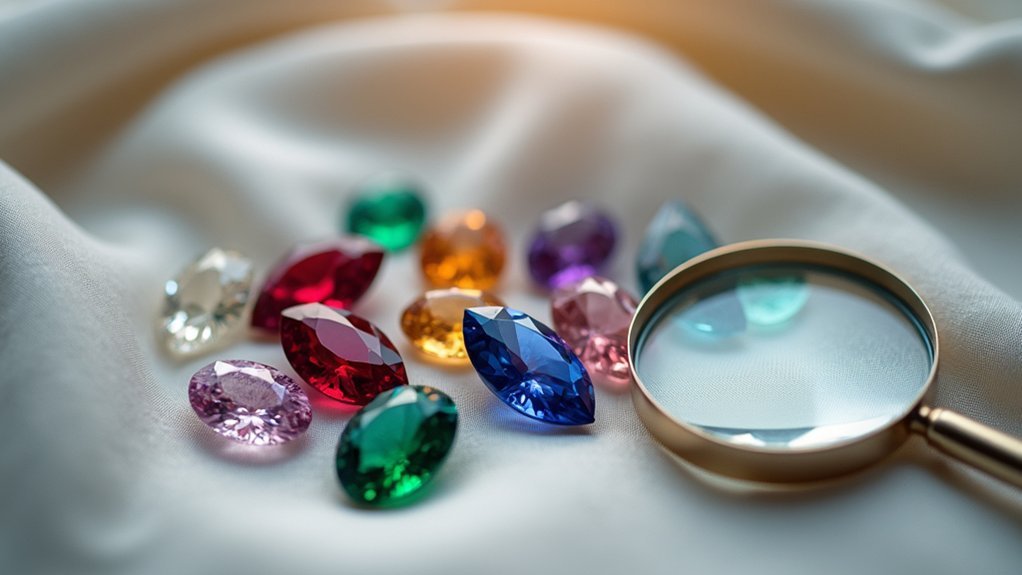
When you’re selecting gemstones for jewelry design, you’ll need to master the Four Cs—Color, Clarity, Cut, and Carat—since these fundamental criteria determine both a stone’s beauty and its market value.
Color stands as the most vital factor for colored gemstones. You’ll evaluate three components: hue (the dominant color), tone (lightness or darkness), and saturation (purity). The more vivid and pure the color, the more valuable your stone becomes.
Clarity examines internal inclusions and external blemishes. Fewer flaws mean better light transmission and enhanced beauty.
Cut determines how effectively your gemstone reflects light, creating sparkle and brilliance. Different cutting styles suit various stone types.
Finally, carat measures weight. While larger stones typically cost more, don’t overlook superior color and clarity in smaller gems—they often outweigh size considerations.
Matching Gemstone Colors to Design Vision
You’ll transform your jewelry designs when you understand how color theory principles guide gemstone selection and pairing decisions.
Start by exploring complementary colors like purple amethyst with golden citrine to create dynamic visual tension, or choose analogous hues for subtle, sophisticated combinations.
Master these fundamentals, and you’ll consistently create harmonious palettes that bring your design vision to life with striking impact.
Color Theory Fundamentals
Color theory serves as the foundation for creating jewelry pieces that truly resonate with your design vision, requiring you to master three essential components: hue, tone, and saturation. Hue represents the dominant color of your chosen gemstone, while tone determines its lightness or darkness. Saturation measures the intensity or purity of that color.
Understanding these fundamentals transforms your approach to gemstone jewelry selection. You’ll create striking contrasts by pairing complementary colors—imagine blue sapphires against orange garnets.
Alternatively, achieve sophisticated depth through tonal harmonies using similar colors in varying shades for gradient effects.
Don’t overlook emotional significance when applying color theory. Red rubies convey passion, while blue aquamarines evoke tranquility.
Experiment boldly with different shapes, cuts, and colors to develop innovative designs reflecting your unique personality and style preferences.
Harmonious Palette Creation
Before achieving visual harmony in your jewelry design, mastering the strategic pairing of gemstone colors establishes the emotional and aesthetic foundation of your piece.
For harmonious palette creation, use the color wheel to identify complementary combinations—pair warm ruby red with cool emerald green for striking contrasts. Balance color saturation by matching vibrant cobalt blue sapphires with softer pale pink tourmaline, creating visual interest without overwhelming your design.
Explore tonal harmonies using similar hues with varying intensities, like deep lapis lazuli alongside light aquamarine for gradient effects.
In custom jewelry, incorporate birthstones or meaningful gems that resonate emotionally. Remember that gemstone cuts influence color interaction—cabochon cuts create unified looks when paired with similar-toned stones, enhancing overall design harmony.
Evaluating Durability for Intended Wear
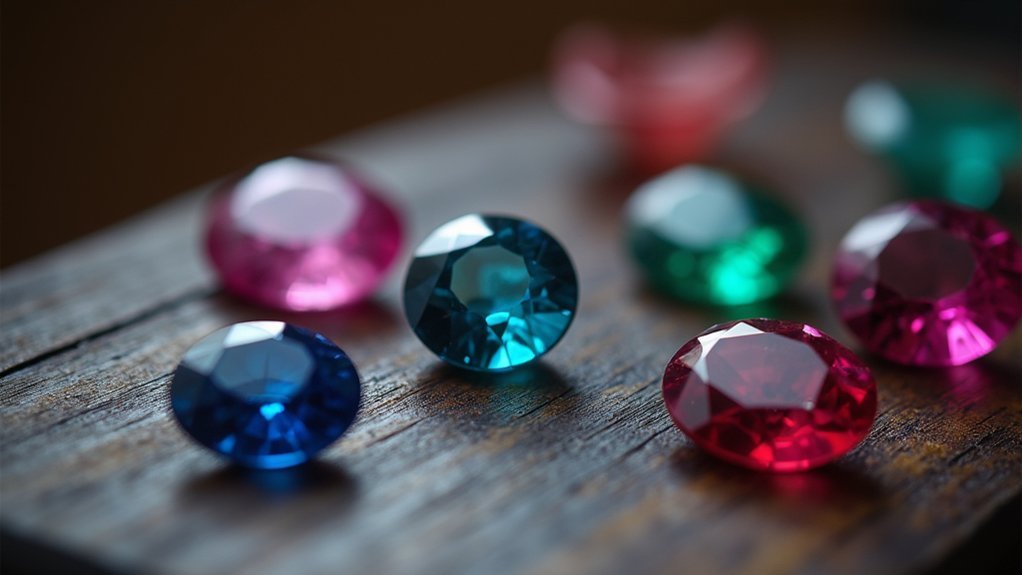
You’ll need to assess each gemstone’s hardness using the Mohs scale to determine if it can handle your jewelry’s intended use.
Consider whether you’re designing a daily-wear engagement ring that requires a durable stone like diamond or sapphire, versus an occasional-wear piece that can accommodate softer gems.
Choose protective settings and mounting styles that shield vulnerable stones from impacts and scratches based on their hardness ratings.
Mohs Scale Rankings
When selecting gemstones for jewelry design, understanding the Mohs scale becomes essential for matching stone durability with intended wear patterns. This 1-10 rating system measures scratch resistance, helping you make informed decisions about gemstone placement and setting requirements.
The Mohs scale categorizes stones into three practical durability groups:
- Premium durability (8-10): Diamonds, sapphires, and rubies withstand daily wear, making them perfect for engagement rings and frequently worn pieces that’ll face constant contact with surfaces.
- Moderate durability (6-8): Emeralds, aquamarine, and tanzanite require protective settings and careful handling, ideal for special occasion jewelry that won’t endure rough treatment.
- Delicate specimens (5-6): Pearls and amber need gentle care, suited for statement pieces you’ll wear occasionally rather than everyday essentials.
Daily Wear Considerations
Choosing the right gemstone hardness rating sets the foundation, but your specific lifestyle habits determine which stones will truly thrive in your daily routine. For everyday jewelry pieces like engagement rings and work accessories, you’ll want stones rated 7 or higher on the Mohs scale to resist scratches from daily activities.
| Hardness Rating | Gemstone Examples | Best Use |
|---|---|---|
| 9-10 | Diamonds, Sapphires, Rubies | Daily wear jewelry |
| 7-8 | Emeralds, Aquamarines | Occasional wear pieces |
| 5-6 | Opals, Turquoise | Special occasions only |
Consider lower-profile settings for softer stones to minimize damage risks. Your active lifestyle demands durable choices, while gentler routines allow for more delicate gemstone options in your jewelry collection.
Setting Protection Methods
The setting you select acts as your gemstone’s first line of defense against everyday hazards. When choosing setting protection methods for softer stones rated 6-7 on the Mohs scale, you’ll need strategic approaches that shield vulnerable areas while maintaining beauty.
Consider these protective setting options for everyday wear:
- Bezel settings – A metal rim completely surrounds your stone’s perimeter, creating an impenetrable barrier against impacts and scratches.
- Flush settings – Your gemstone sits level with the metal surface, eliminating raised edges that catch on clothing or objects.
- Halo designs – Surrounding diamonds or harder stones create a protective buffer zone around your center gemstone.
You should match your setting choice to your stone’s hardness rating and your lifestyle demands, ensuring longevity without compromising style.
Balancing Budget With Quality Expectations
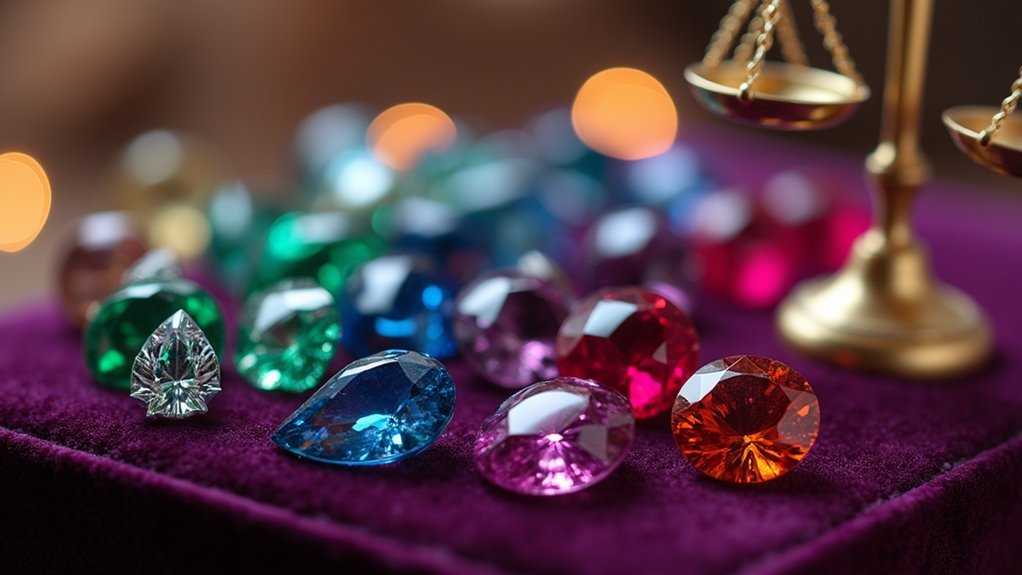
Although gemstone selection often feels like choosing between quality and affordability, you can achieve both with strategic decision-making.
When balancing budget with quality expectations, especially for engagement rings, prioritize color and clarity over carat weight. These factors dramatically impact visual appeal while keeping costs manageable.
Establish a clear budget first, then explore alternative gemstones offering similar aesthetics to expensive options—high-quality amethyst instead of costly sapphire, for example.
Purchase loose stones directly from reputable jewelers or capitalize on sales to maximize value.
Be mindful of treated gemstones, which can reduce costs but may affect durability and care requirements. Understanding these treatments helps you make informed decisions that align with your quality expectations while staying within budget constraints.
Selecting Cuts That Enhance Light Performance
When you’re ready to maximize your gemstone’s brilliance, selecting the right cut becomes your most powerful tool for enhancing light performance.
Faceted cuts like brilliant or step cuts excel at reflecting and refracting light, making diamonds, sapphires, and rubies absolutely stunning. You’ll want to take into account your stone’s optical properties when choosing—tanzanite’s pleochroism shines with faceted cuts, while cabochon cuts enhance opaque stones’ natural beauty.
The secret to unlocking your gemstone’s full potential lies in matching the perfect cut to its unique optical characteristics.
Key elements that maximize light performance:
- Perfect proportions – Depth-to-width ratios that balance light entry and exit for ideal brilliance
- Strategic facet placement – Multiple surfaces that capture and redirect light from every angle
- Precise angles – Mathematical precision that creates maximum sparkle and fire
Considering Gemstone Treatments and Disclosures
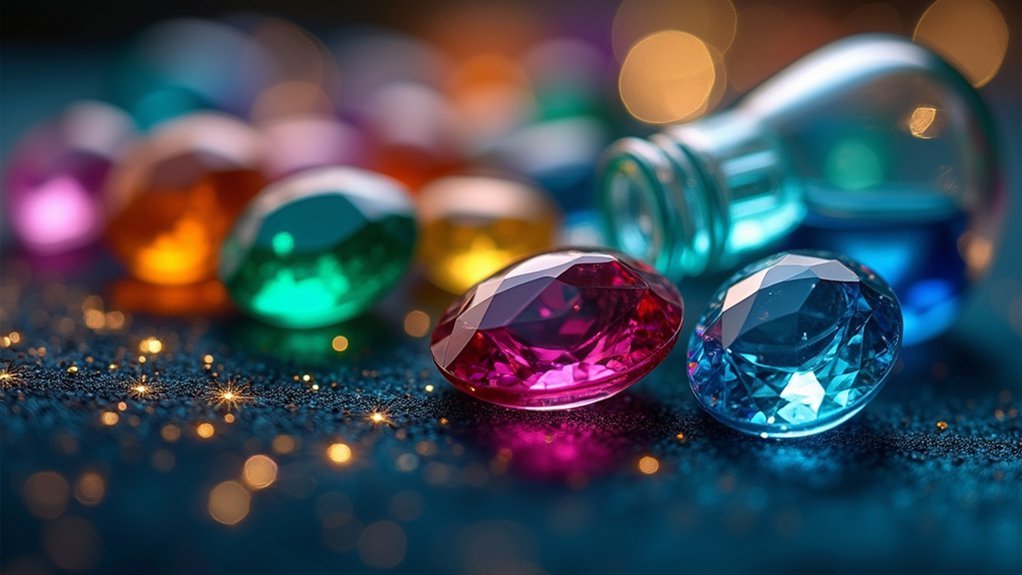
Before making your final gemstone selection, you’ll need to understand the treatment history that could dramatically impact both value and care requirements.
Gemstones commonly undergo heat treatment, dyeing, or filling to enhance color and clarity. The FTC requires jewelers to disclose any enhancements affecting value, so don’t hesitate to ask direct questions about gemstone treatments before purchasing.
Natural stones typically command higher values than treated counterparts, making disclosure essential for informed decisions.
Some treatments are permanent, while others demand special care to maintain appearance. You should inquire about maintenance requirements for treated stones to preserve their beauty long-term.
Ethical purchasing practices rely on complete transparency regarding treatments, ensuring integrity throughout the jewelry industry and protecting your investment.
Choosing Settings That Complement Stone Characteristics
Since each gemstone possesses unique physical properties and visual characteristics, you’ll need to select settings that enhance these qualities while providing appropriate protection.
Transparent stones like diamonds and sapphires thrive in prong settings that maximize light exposure and brilliance. Softer stones such as opals and turquoise benefit from protective bezel settings that maintain sleek aesthetics for everyday wear.
Choose settings that complement each gemstone’s unique properties—prong settings for transparent stones, bezel settings for softer gems requiring protection.
Meanwhile, halo settings elevate larger gems like emeralds by surrounding them with accent stones.
Consider these setting approaches for your piece of jewellery:
- Channel settings for anniversary bands featuring multiple stones in continuous, secure arrangements
- Pavé settings for creating dazzling textured surfaces around focal stones in rings
- Bezel settings for protecting delicate gems while ensuring durability and modern appeal
Frequently Asked Questions
How to Choose Gemstone Jewelry?
You’ll want to take into account color quality, clarity levels, and durability ratings above 7 on Mohs scale. Choose stones with personal meaning, ask about treatments, and make certain they’ll withstand your intended wear frequency.
What Are the 4 C’s of Gemstones?
You’ll evaluate gemstones using the 4 C’s: Color, which determines hue and saturation; Clarity, measuring inclusions; Cut, affecting light reflection and sparkle; and Carat, indicating the stone’s weight.
How Do You Select Your Gemstone?
You’ll select your gemstone by evaluating color’s hue, tone, and saturation, checking clarity for inclusions, considering cut quality for light performance, analyzing durability needs, and choosing stones with personal meaning.
What Are the Three Factors That Are Considered When Determining a Gems Value?
You’ll evaluate three primary factors when determining a gem’s value: Color, which is most critical for colored stones; Clarity, examining inclusions and flaws; and Cut, influencing light reflection and brilliance.
In Summary
You’ll create stunning jewelry by mastering these seven gemstone selection principles. Remember, there’s no single “perfect” stone—only the right choice for your specific design goals and budget. Don’t rush your selection process; take time to examine multiple options under different lighting conditions. Trust your instincts while applying technical knowledge, and always verify treatments and authenticity. With practice, you’ll develop an eye for selecting gemstones that truly elevate your designs.

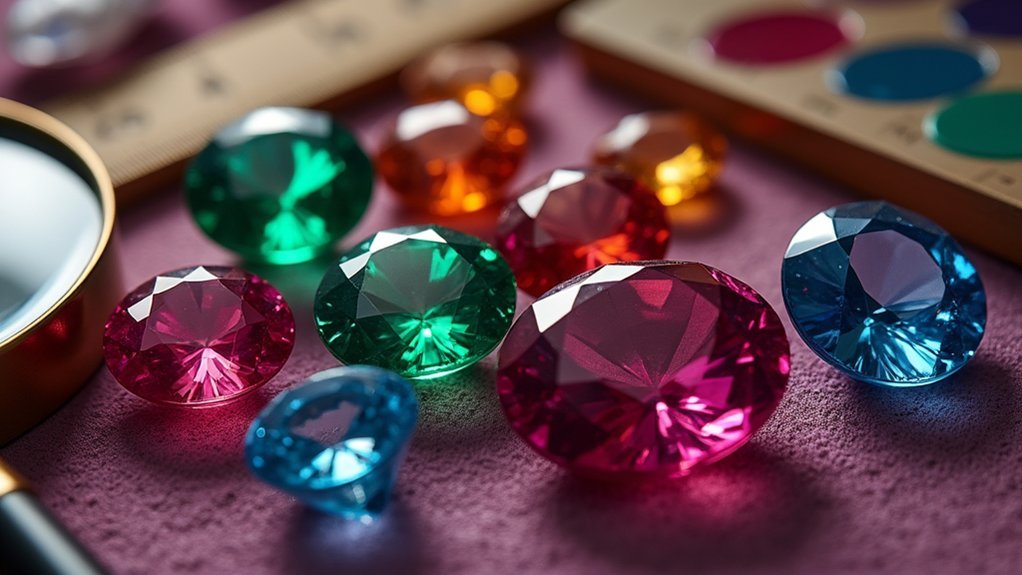



Leave a Reply